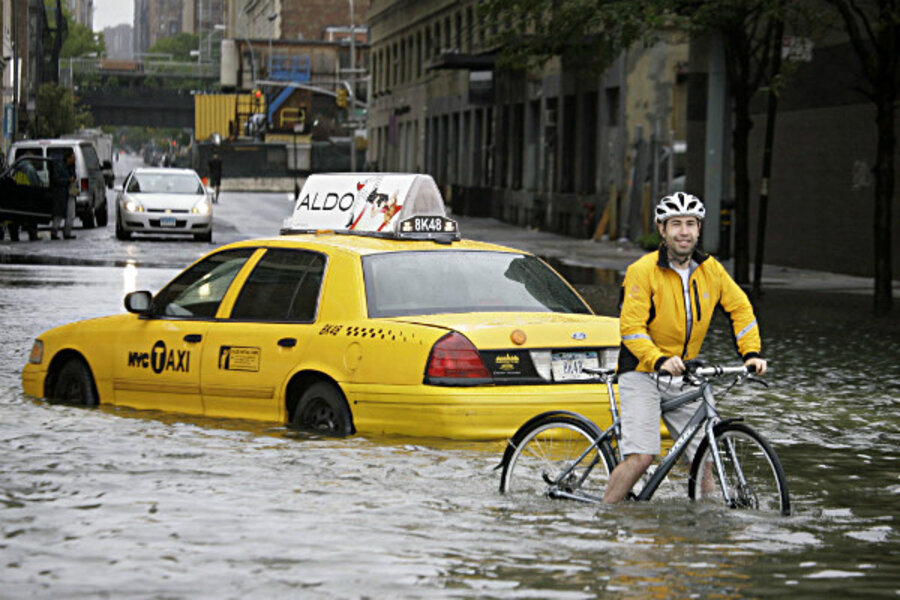Sea levels rising on US East Coast much faster than global average
Loading...
| Washington
Sea levels are rising much faster along the U.S. East Coast than they are around the globe, putting one of the world's most costly coasts in danger of flooding, government researchers report.
U.S. Geological Survey scientists call the 600-mile (965-kilometer) swath a "hot spot" for climbing sea levels caused by global warming. Along the region, the Atlantic Ocean is rising at an annual rate three times to four times faster than the global average since 1990, according to the study published Sunday in the journal Nature Climate Change.
It's not just a faster rate, but at a faster pace, like a car on a highway "jamming on the accelerator," said the study's lead author, Asbury Sallenger Jr., an oceanographer at the agency. He looked at sea levels starting in 1950, and noticed a change beginning in 1990.
Since then, sea levels have gone up globally about 2 inches (5 centimeters). But in Norfolk, Virginia, where officials are scrambling to fight more frequent flooding, sea level has jumped a total of 4.8 inches (12.19 centimeters), the research showed. For Philadelphia, levels went up 3.7 inches (9.4 centimeters), and in New York City, it was 2.8 inches (7.11 centimeters).
Climate change pushes up sea levels by melting ice sheets in Greenland and west Antarctica, and because warmer water expands.
Computer models long have projected higher levels along parts of the East Coast because of changes in ocean currents from global warming, but this is the first study to show that's already happened.
By 2100, scientists and computer models estimate that sea levels globally could rise as much as 3.3 feet (1.01 meters). The accelerated rate along the East Coast could add about 8 inches (20 centimeters) to 11 inches (28 centimeters) more, Sallenger said.
"Where that kind of thing becomes important is during a storm," Sallenger said. That's when it can damage buildings and erode coastlines.
On the West Coast, a National Research Council report released Friday projects an average 3-foot (nearly 1-meter) rise in sea level in California by the year 2100, and 2 feet (0.61 meters) in Oregon and Washington. The land mass north of the San Andreas Fault is expected to rise, offsetting the rising sea level in those two states.
The USGS study suggests the Northeast would get hit harder because of ocean currents. When the Gulf Stream and its northern extension slow down, the slope of the seas changes to balance against the slowing current. That slope then pushes up sea levels in the Northeast. It is like a see-saw effect, Sallenger theorizes.
Scientists believe that with global warming, the Gulf Stream and other ocean currents are slowing and will slow further, Sallenger said.
Jeff Williams, a retired USGS expert who wasn't part of the study, and Stefan Rahmstorf, a professor of ocean physics at the Potsdam Institute in Germany, said the study does a good job of making the case for sea level rise acceleration.
Margaret Davidson, director of the Coastal Services Center for the National Oceanic and Atmospheric Administration in Charleston, South Carolina, said the implications of the new research are "huge when you think about it. Somewhere between Maryland and Massachusetts, you've got some bodaciously expensive property at risk."
Sea level projections matter in coastal states because flood maps based on those predictions can result in restrictions on property development and affect flood insurance rates.
Those estimates became an issue in North Carolina recently when the Legislature proposed using historic figures to calculate future sea levels, rejecting higher rates from a state panel of experts. The USGS study suggests an even higher level than the panel's estimate for 2100.
The North Carolina proposal used data from University of Florida professor Robert Dean, who had found no regional differences in sea level rise. Dean said he can't argue with the results from Sallenger's study showing accelerating sea level rise in the region, but he said it's more likely to be from natural cycles. Sallenger said there is no evidence to support that claim.
[Editor's note: An earlier headline mischaracterized the sea level rise. The study found that the seas on the East Coast are have been rising at an annual rate three times to four times faster than the global average.]
___
Associated Press writers Allen Reed in Raleigh, North Carolina, and Jeff Barnard in Grants Pass, Oregon, contributed to this report.
___







